An Introduction to Legacy System Modernization
Anna Rózga

Is outdated technology holding your business back? It's time to break free from the shackles of technical debt and bridge the gap between the past and the future. Let's discover why modernizing your legacy system isn't just a choice, but a necessity for staying competitive in today's digital landscape.
This article marks the beginning of our new series dedicated to legacy modernization. Our goal is to offer a thorough introduction to the topic before delving into specifics. Read on to:
- Understand what legacy systems are.
- Identify common challenges associated with outdated software.
- Uncover the key benefits of modernization.
- Explore the 6R framework.
- Learn how we modernize legacy systems at hero/dot.
- Discover guidelines for selecting the right technology partner.
What Are Legacy Systems?
The term "legacy system" refers to outdated or older systems, applications, or software platforms that are still in use within an organization but may no longer be actively developed or maintained. These systems typically have been in operation for years or decades and may have been built using outdated technologies, languages, or methodologies.
If you're reading this, chances are your system falls under the legacy umbrella and faces significant challenges as a result. Poor performance, high maintenance costs, and declining competitiveness... they all sound familiar, don't they? You might wonder, "Does my system need modernization?". To help you find the answer, let's explore some common challenges associated with legacy systems. If most of them resonate with you, you're in the right place!
Common Challenges of Legacy Systems
Technical Debt
Technical debt refers to the long-term costs incurred from taking a short-sighted approach to software development. Whether intentional or not, shortcuts are taken and omissions are made for the sake of quick software delivery. However, those suboptimal solutions accumulate over time, resulting in higher maintenance costs, poor performance, and unresolved issues.
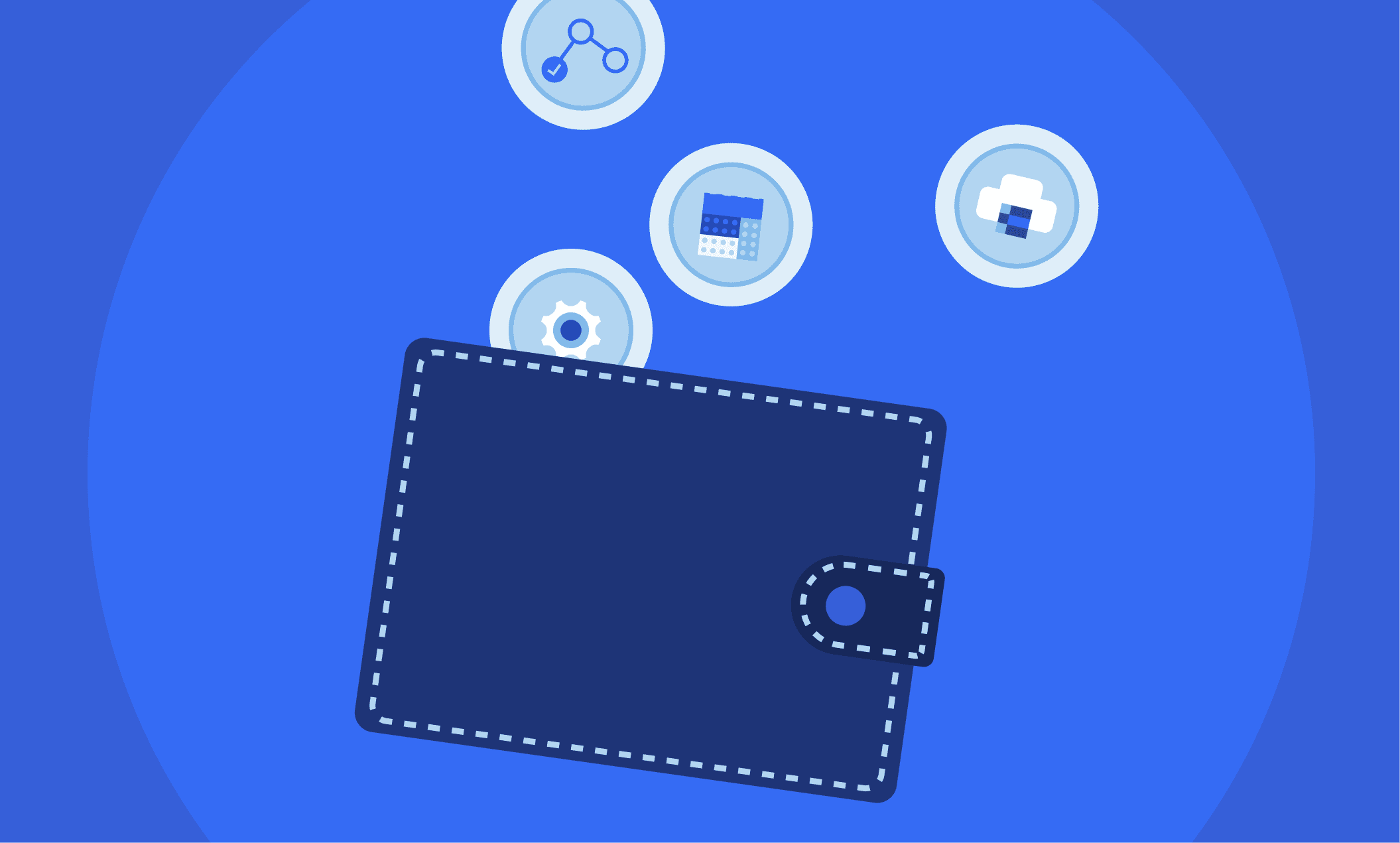
Outdated Technology
In the fast-paced programming landscape, systems that are 10 or 20 years old are considered ancient. From a modern standpoint, legacy systems often use outdated programming languages, frameworks, and tools that are no longer widely used. This can cause compatibility issues, security vulnerabilities, not to mention the immense difficulties in finding skilled developers to maintain legacy code.
Integration Challenges
Relying on outdated technology stacks limits options for modern integrations, APIs, and data exchange formats. The results are detrimental, as this lack of compatibility hinders workflow automation, optimization of business processes, and digital transformation efforts. Without necessary integrations, companies risk wasting resources and falling behind more forward-thinking competitors.
Limited Documentation
A tale as old as time: the legacy modernization team requests the system documentation files, only to discover there are none! It's common for legacy software to lack comprehensive documentation, such as requirement specifications, architecture diagrams, and technical manuals. This poses significant challenges for developers and business analysts involved in modernization efforts, as understanding the system, identifying dependencies, and making changes to the code becomes a real tough nut to crack.
High Complexity & Low Scalability
Legacy systems are often complex, with intertwined webs of dependencies, layers of customization, and convoluted business logic. This complexity can make it difficult to diagnose issues, implement changes, and ensure system stability. Additionally, low scalability limits the ability to accommodate growing needs and expand business operations, leading to performance issues, bottlenecks, and system downtime.
Resistance to Change
At hero/dot, we believe that resistance to change poses the greatest threat to an organization's survival in the market. Partnering with an experienced software house can help overcome challenges related to technical debt, integrations, and scalability. However, none of this is possible without a willingness to embrace change. That's why it's crucial to realize that the fear of disrupting the status quo impedes the adoption of new technologies or business practices necessary for staying competitive.
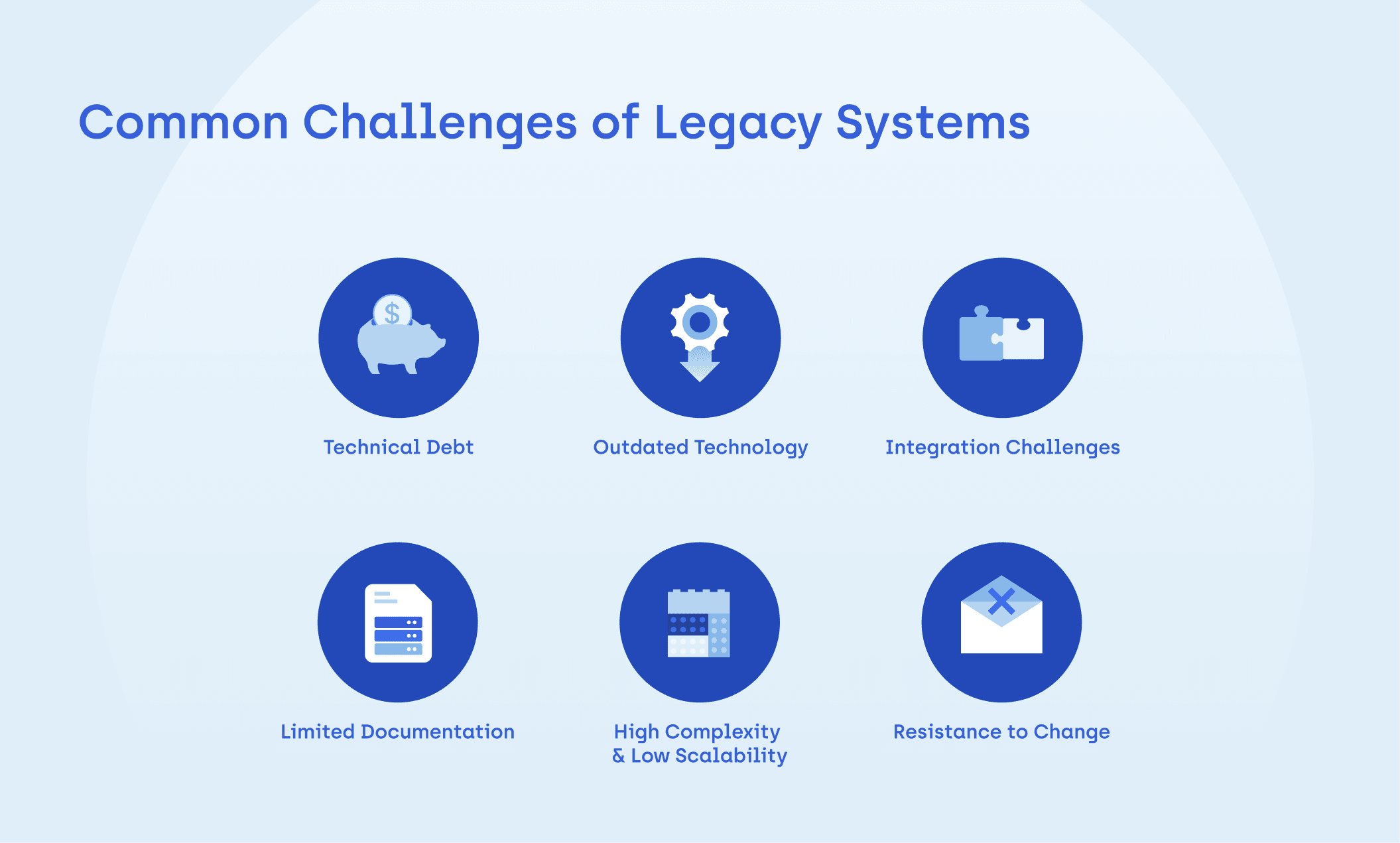
In other words: where there's a will, there's a way! To help you visualize what your system can become if you're willing to embrace digital transformation, let's explore the key benefits of legacy modernization.
Benefits of Legacy System Modernization
Strategic Alignment
Unlike off-the-shelf, low-code solutions, legacy system modernization delivered by an experienced technology partner is finely tailored to your unique business objectives. At hero/dot, we seize the pre-implementation analysis stage as a prime opportunity to delve deeply into your business model, proposing solutions that optimize both strategy and technology.
Improved Performance
If you've noticed your solution struggling under the weight of technical debt, modernization is your highway to maximized performance. Upgrading legacy code, optimizing infrastructure, and harnessing cutting-edge technologies can propel your organization's systems to achieve unprecedented results.
Cost Savings
Modernizing legacy software, especially with large transformation projects, may seem resource-intensive upfront. However, view it as an investment that yields significant cost savings over time. By reducing maintenance and infrastructure expenses, streamlining processes, and improving operational efficiency, you'll find yourself reaping rewards sooner than you imagined.
Increased Agility
Legacy modernization is like opening one door to countless opportunities. Your new system will provide a solid foundation for innovation, unlock new capabilities, and allow your organization to respond swiftly to evolving market dynamics. Whether navigating regulatory changes or rolling out new features, modernized software ensures you're equipped to meet every challenge head-on.
Enhanced User Experience
Modernized systems not only upgrade technologically, but also undergo a UX/UI makeover. Through modern interfaces, intuitive workflows, and responsive design, you can enhance usability and satisfaction for end users. Boosted engagement, productivity, and sales are just a few tangible benefits of embarking on the modernization journey.
Risk Mitigation
Modernized systems integrate the latest security features, best practices, and compliance standards to protect against cyber threats, data breaches, and regulatory violations. By addressing vulnerabilities and strengthening security controls, organizations can mitigate risks and safeguard sensitive information.
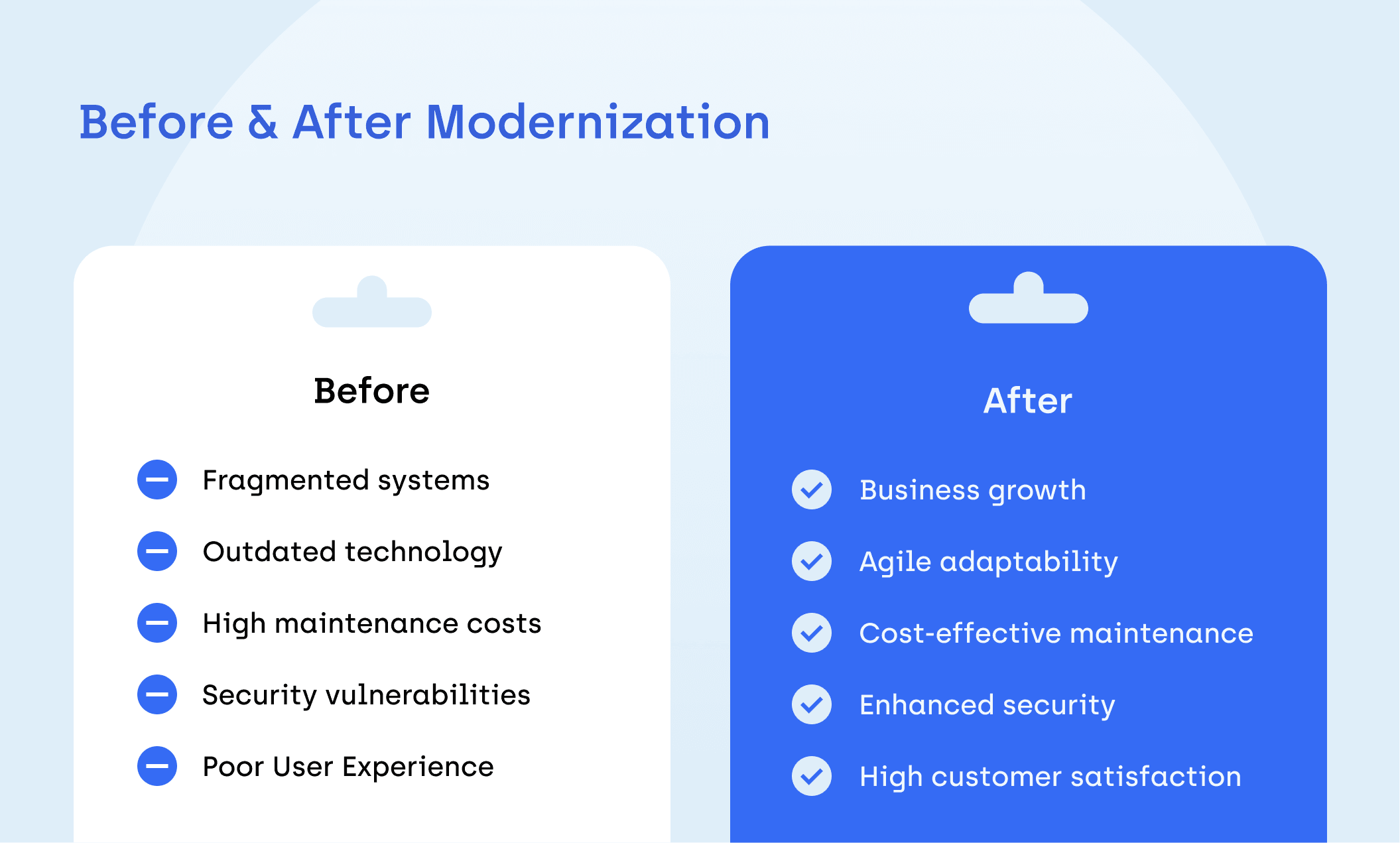
Approaches to Legacy System Modernization: The 6R Framework
The 6R framework outlines six common approaches to legacy modernization, all beginning with the letter R: rehost, replatform, refactor, rearchitect, rebuild, and replace. To provide insight into the strategy behind each approach, we've included a list of pros and cons, along with a scenario where each approach is the most fitting choice.
Rehost
Rehosting, also known as "lift and shift", involves moving an exact copy of an application or system to a new hosting environment, typically from on-premises to a public or private cloud. This approach offers immediate benefits such as scalability and cost savings without requiring major changes to the system's architecture or functionality.
Pros:
- Smooth Migration: Rehosting usually involves a quick and straightforward migration process, reducing downtime and disruption to operations to minimum.
- Cost Savings: It can lead to instant cost savings by utilizing the scalability and cost-efficiency of cloud platforms.
- You can read more about the benefits of cloud migration in this article.
Cons:
- Limited Optimization: Lift and shift may not tackle underlying issues in the application's architecture or design, missing opportunities to enhance performance or utilize modern technologies.
When Does It Work Best?
Rehosting is ideal when an organization needs to swiftly and seamlessly migrate a legacy application to a new infrastructure, such as transitioning from on-premises to a cloud platform. It's optimal when the application itself doesn't require significant changes to its architecture and functionality; otherwise, opting for this approach may not suffice for legacy application modernization.
Replatform
Replatforming involves making minor adjustments to an application or system to optimize it for a more modern environment, such as updating dependencies, libraries, or configurations to align with the target platform's requirements.
Pros:
- Improved Performance: Replatforming lets organizations capitalize on performance enhancements offered by the target platform, like faster processing speeds or better resource utilization.
- Reduced Risk: Replatforming lowers risks linked with extensive modernization processes. It focuses on gradual changes that maintain the application's core functions and compatibility.
Cons:
- Limited Transformation: This strategy may not address deeper architectural or design issues in the application, limiting opportunities for innovation.
- Technical Debt: Replatforming may encounter compatibility issues that require workarounds to match the target platform's requirements. This could lead to less-than-ideal solutions, potentially introducing technical debt.
When Does It Work Best?
Replatforming shines when an organization aims to modernize a legacy application to enhance its performance while minimizing disruption and risk. For instance, migrating an on-premises application to a containerized environment to enjoy container orchestration and scalability perks while retaining its existing functionality and architecture. If your company has amassed technical debt and might face compatibility issues, considering a different strategy would be wiser.
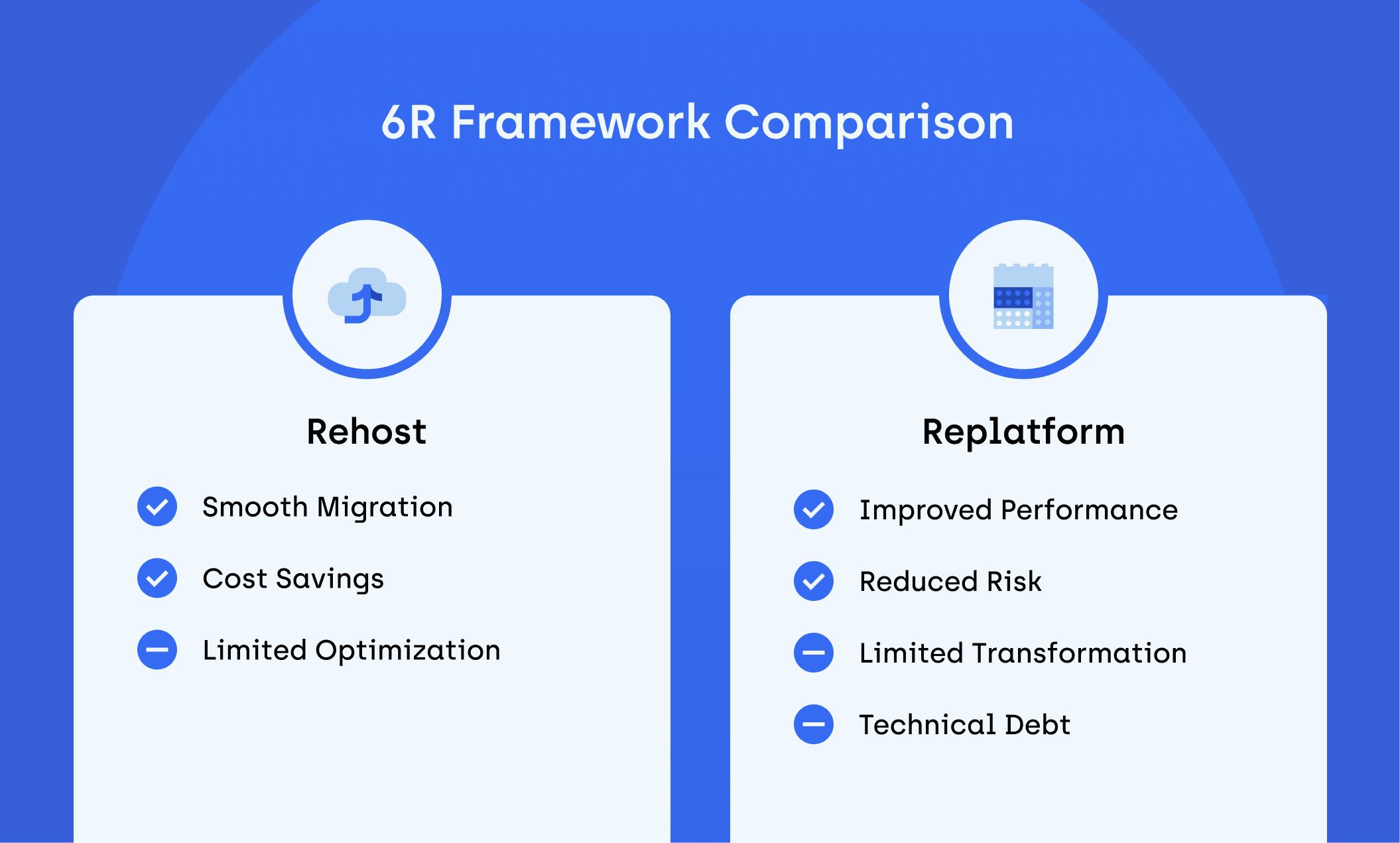
Refactor
Refactoring involves improving the codebase, architecture, or design of a legacy system while retaining its core functionality. This includes tasks like code cleanup, restructuring, optimization, and applying best practices.
Pros:
- Improved Maintainability: Refactoring streamlines and organizes the codebase, making it easier to comprehend, debug, and maintain over time.
- Reduced Technical Debt: This strategy addresses accumulated technical debt, reducing complexity, optimizing critical components and lowering the risk of future issues.
Cons:
- Time-Consuming: Refactoring can be time-consuming and resource-intensive, requiring careful planning, testing, and coordination to prevent disruptions.
- Limited Transformation: Refactoring may not fix fundamental architectural or design flaws in the system, which may require a different approach out of the 6R.
When Does It Work Best?
Refactoring is a fitting approach when the existing system has a strong foundation but suffers from poor code quality, technical debt, or performance issues. To ensure successful outcomes, a company should adopt a systematic approach to refactoring. This involves breaking down extensive refactorings into smaller, more manageable tasks and consistently monitoring for any disruptions, regressions, or potential data loss throughout the process.
Rearchitect
Rearchitecting is about redesigning the architecture of a legacy system to adopt modern technologies, architectures, and patterns. This might involve breaking down monolithic applications, migrating to microservices, or embracing a serverless approach.
Pros:
- Flexibility and Resilience: Rearchitecting allows organizations to utilize modern architectures to scale dynamically, handle peak workloads, and adapt to changing business needs.
Cons:
- Complexity and Risk: Rearchitecting is a complex and high-risk endeavor that requires careful planning, coordination, and expertise to avoid disruptions. Challenges may arise related to data migration, compatibility, and integration with existing systems, which necessitates thorough testing and validation for a smooth transition.
- Cost and Resource Intensiveness: Rearchitecting may require significant investment in resources, expertise, and infrastructure to implement and maintain the new architecture, which can potentially impact budgets and timelines.
When Does It Work Best?
Rearchitecting is a suitable strategy when the existing system is monolithic, tightly coupled, or struggles to scale to meet growing business demands. A good example would be rearchitecting a monolithic application into microservices to enhance scalability and agility while preserving its core functionality and business logic. However, before committing to this strategy, thorough pre-implementation analysis is crucial for crafting an actionable modernization plan.
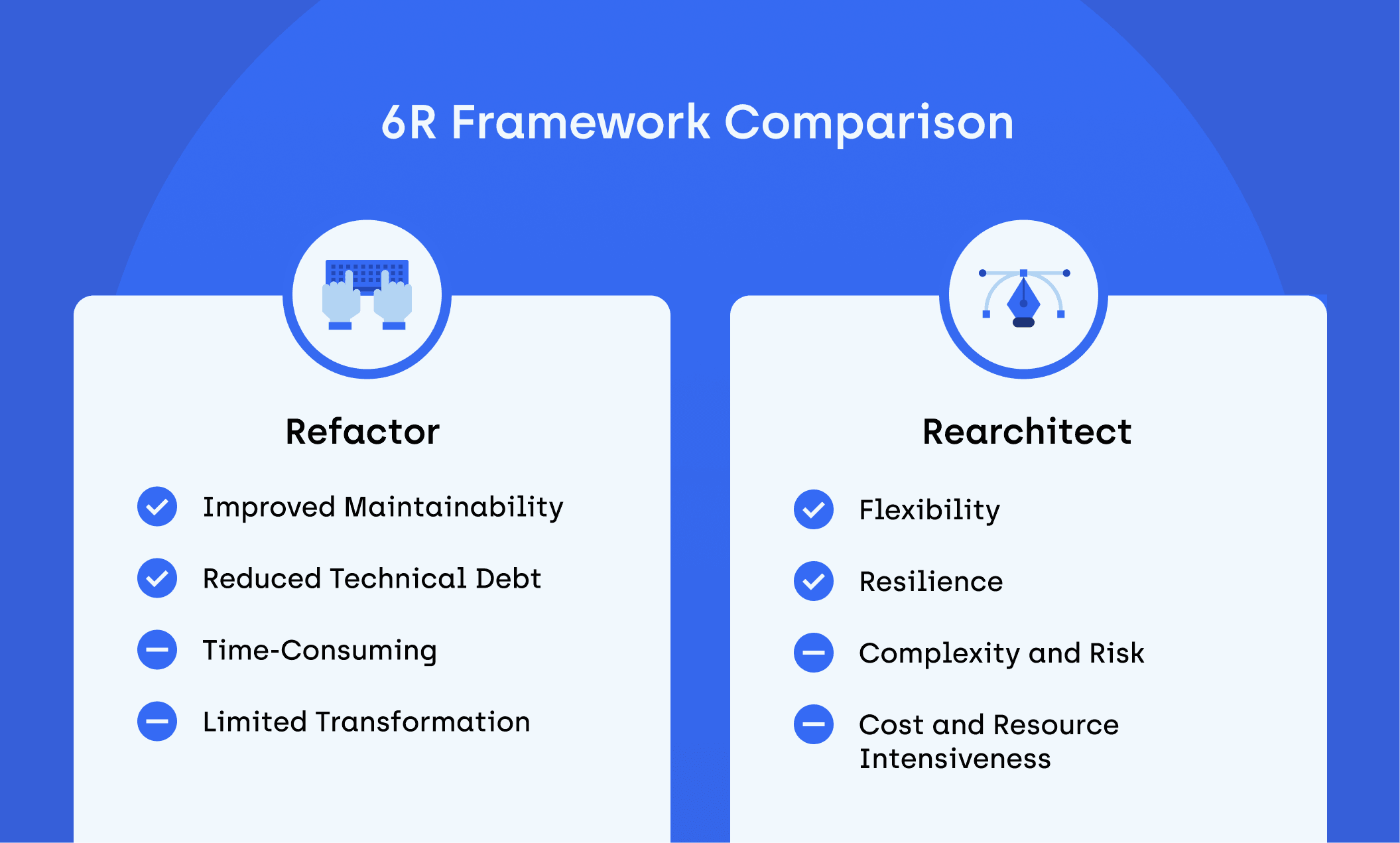
Rebuild
Rebuilding involves developing a legacy system from scratch using modern technologies, architectures, and methodologies without changing the core functionality and requirements. This approach offers an opportunity to address technical debt while leveraging lessons learned from past legacy issues.
Pros:
- Fresh Start: Rebuilding provides a clean slate, allowing developers to design and implement the new solution without being bound by the limitations of the old system. This freedom enables the use of the latest best practices, tools, and technologies.
- Alignment with Business Goals: Rebuilding allows organizations to realign the system with current business goals, ensuring that the new solution delivers tangible value and meets strategic objectives.
Cons:
- Time and Resource Intensiveness: Rebuilding a system from scratch requires significant investment in time, resources, and expertise, including pre-implementation analysis, design, development, testing, and deployment.
- Risk of Scope Creep: Rebuilding projects are prone to scope creep, as stakeholders may request additional features or changes during the development process, potentially impacting project success.
When Does It Work Best?
Rebuilding is a suitable strategy when the existing system suffers from significant technical debt, architectural limitations, or outdated technologies that cannot be easily addressed through incremental improvements or refactoring. It is also the optimal approach for companies that have strategically pivoted over the years, resulting in misalignment between current business goals and the capabilities of the existing system.
Replace
Replacing entails swapping the existing system for a commercially available off-the-shelf solution provided by a third-party vendor. This approach offers a faster, lower-risk alternative to rebuilding, provided that the off-the-shelf software aligns with the organization's needs.
Pros:
- Rapid Deployment: Replacement solutions are typically ready to deploy, reducing time-to-market and implementation risks compared to custom development.
- Cost-Efficiency: Off-the-shelf solutions often have lower upfront development costs compared to rebuilding, as they leverage existing software assets developed and maintained by third-party vendors.
Cons:
- Limited Customization: Replacement may have limited customization options compared to rebuilding, which means that the chosen solution may leave gaps in meeting all the organization's requirements.
- Integration Challenges: Replacement solutions may require integration with existing systems, data sources, and workflows, which can be complex, time-consuming, or even introduce technical debt.
When Does It Work Best?
Swapping is most effective when the current system is outdated and there are commercially available solutions with comparable or superior features. It's important to note that swapping isn't a suitable alternative to rebuilding if the off-the-shelf solutions fail to meet the organization's specific needs and requirements without extensive customization.
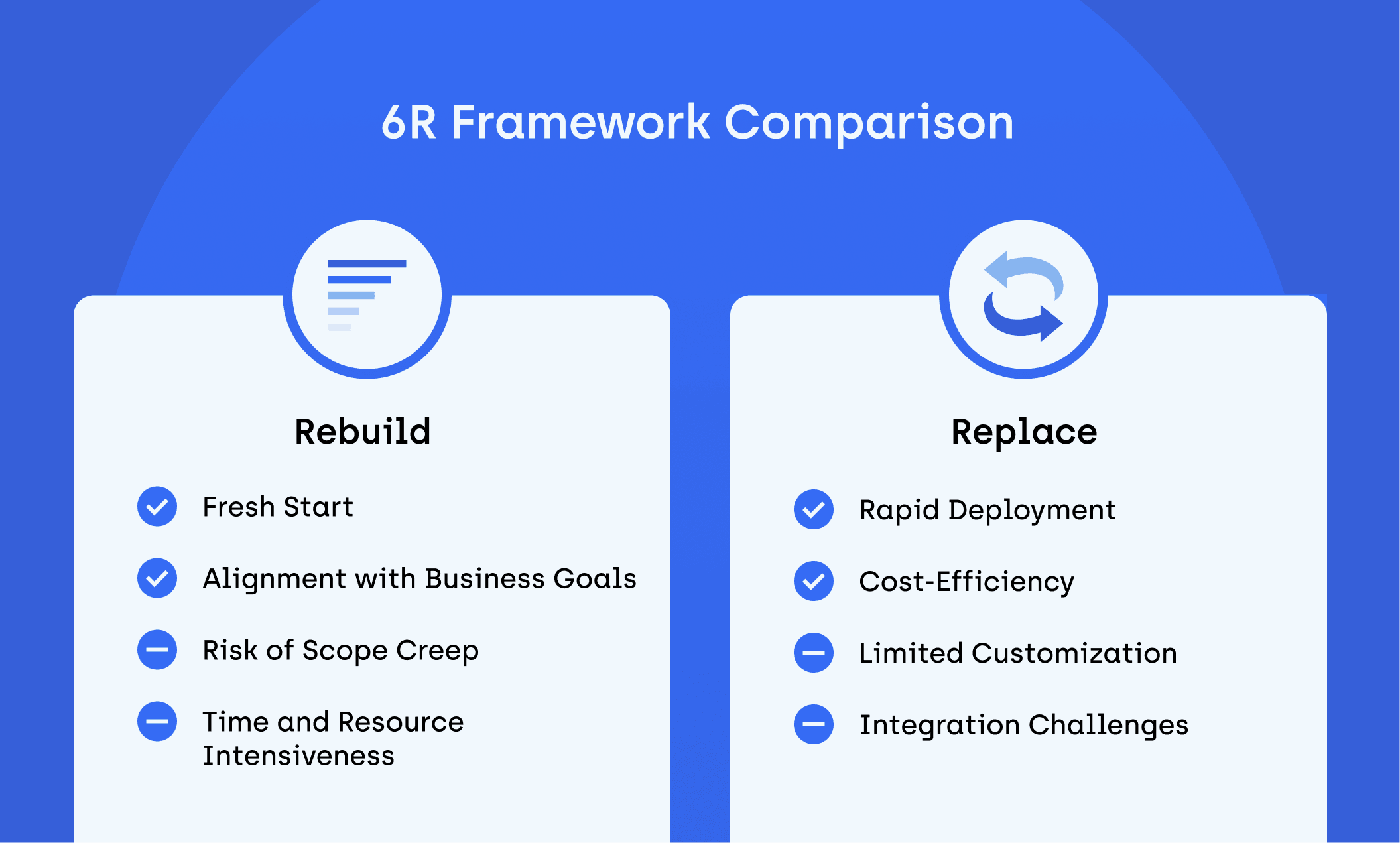
Modernization of Legacy Systems Done the Hero Way
An in-depth exploration of the legacy modernization process warrants its own article. Here, we offer a brief overview of the two pillars central to every successful legacy system modernization project completed by hero/dot: pre-implementation analysis and the SPARK methodology.
Pre-implementation Analysis
Pre-implementation analysis marks the crucial starting point of the legacy modernization journey. It involves a detailed examination of the project scope, functional requirements, resources, potential risks and challenges. The outcome is a comprehensive report detailing identified findings and recommendations, including a suggested modernization strategy, project scope and requirements, recommended technology stack, and more. In essence, we build your vision of a modernized system without touching a single line of code!
You can read more about pre-implementation analysis in our dedicated article or service subpage.
SPARK Methodology
SPARK is a hybrid project management methodology that seamlessly combines the flexibility of agile methodologies with the security of waterfall. Here's how it works:
- Sprints: Following the footsteps of other agile project management methodologies, SPARK divides the software development process into 2-week iterative work cycles known as sprints.
- Rounds: A round consists of 5 standard development sprints, rounding up to 10 weeks. At the conclusion of each round, a project manager checks the underlying assumption and, if needed, makes necessary adjustments based on the team's performance and measured KPIs.
- 75% Minimum Declared Scope: Unlike other methodologies, our hybrid approach guarantees that minimum 75% of the scope for each round is delivered to the client. This figure applies to a round rather than a sprint, allowing for project planning adjustments, even in the face of a worst case scenario. Consequently, we aim high to ensure a robust buffer and maximum deliverability.
For a comprehensive understanding of the SPARK methodology, check out our detailed article.
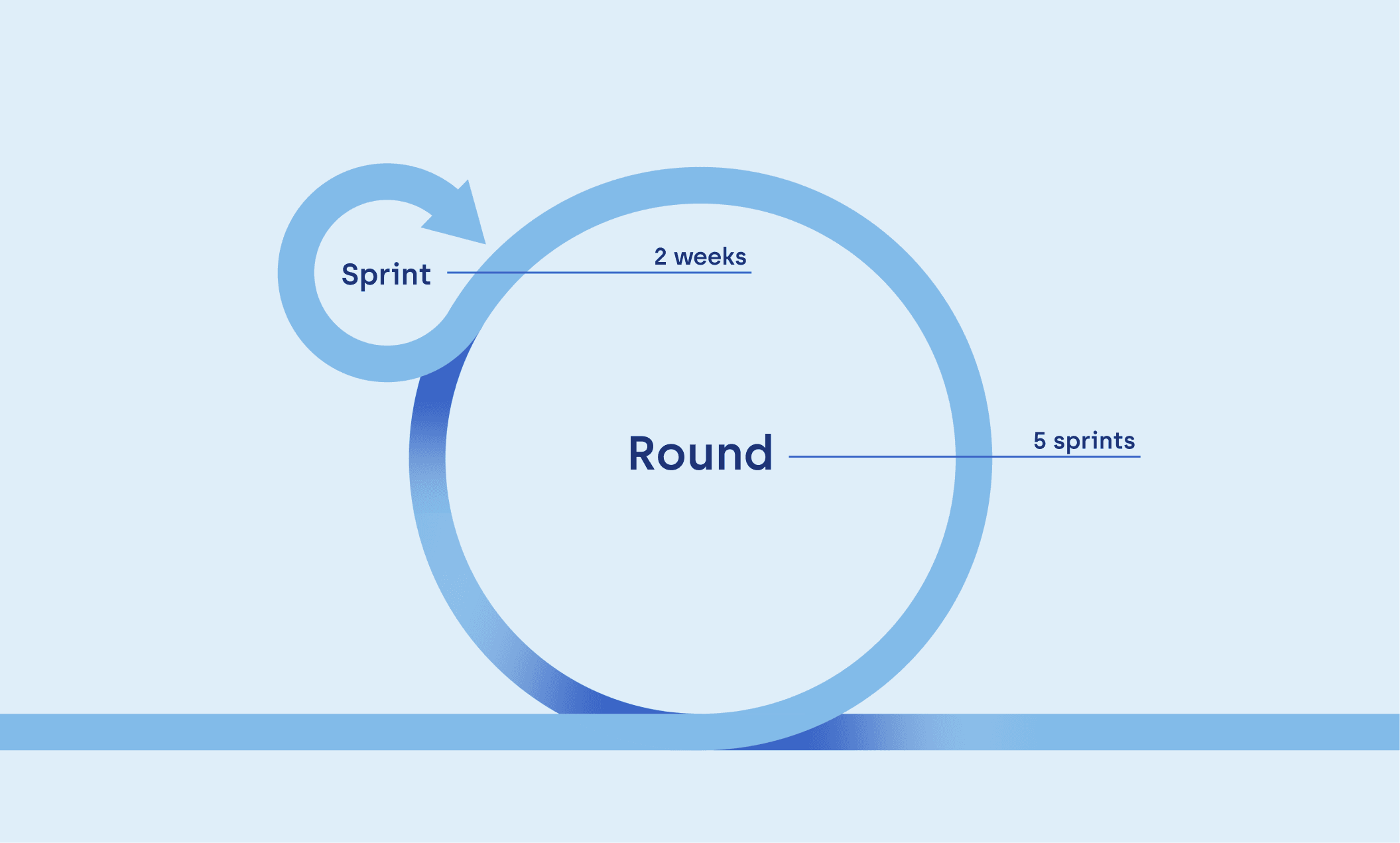
Good Place to Start: Finding the Right Technology Partner
To summarize:
- We've discussed what legacy systems are and highlighted some common challenges they face.
- We've explored the concept of legacy modernization and the benefits it brings.
- We've outlined tried and trusted approaches to modernization.
If your software fits the description, and you're contemplating modernization, choosing the right technology partner is your initial crucial step. This pivotal decision can determine the success of your legacy system modernization process, so careful consideration and due diligence are essential. Here are four guidelines to keep in mind when selecting a business and technology partner:
Expertise and Experience
Seek a partner with a proven track record in legacy modernization, preferably within your industry. Look for a comprehensive package of skills, strategies, methodologies, and experiences. Start by reviewing case studies of similar projects to gain valuable insights into their approach and results.
Technology Stack Compatibility
Ensure the partner is proficient in the technology stack that aligns with your future requirements. They should excel in both legacy systems and modern technologies to facilitate a truly seamless transition.
Strategic Alignment
Choose a partner who understands not only the technical aspects, but also the specific business processes and models of your industry. They should be able to gain a deeper understanding of your business goals and offer strategic insights on how to achieve them. Remember, technology is just 30% of the project's success; the remaining 70% lies in business strategy.
Ongoing Support
Mid- and post-transformation support is vital. Speaking from experience, legacy modernization projects can be lengthy and challenging, requiring numerous difficult decisions and compromises. It's crucial to find a partner who shares your vision and is committed to supporting you through this phase.
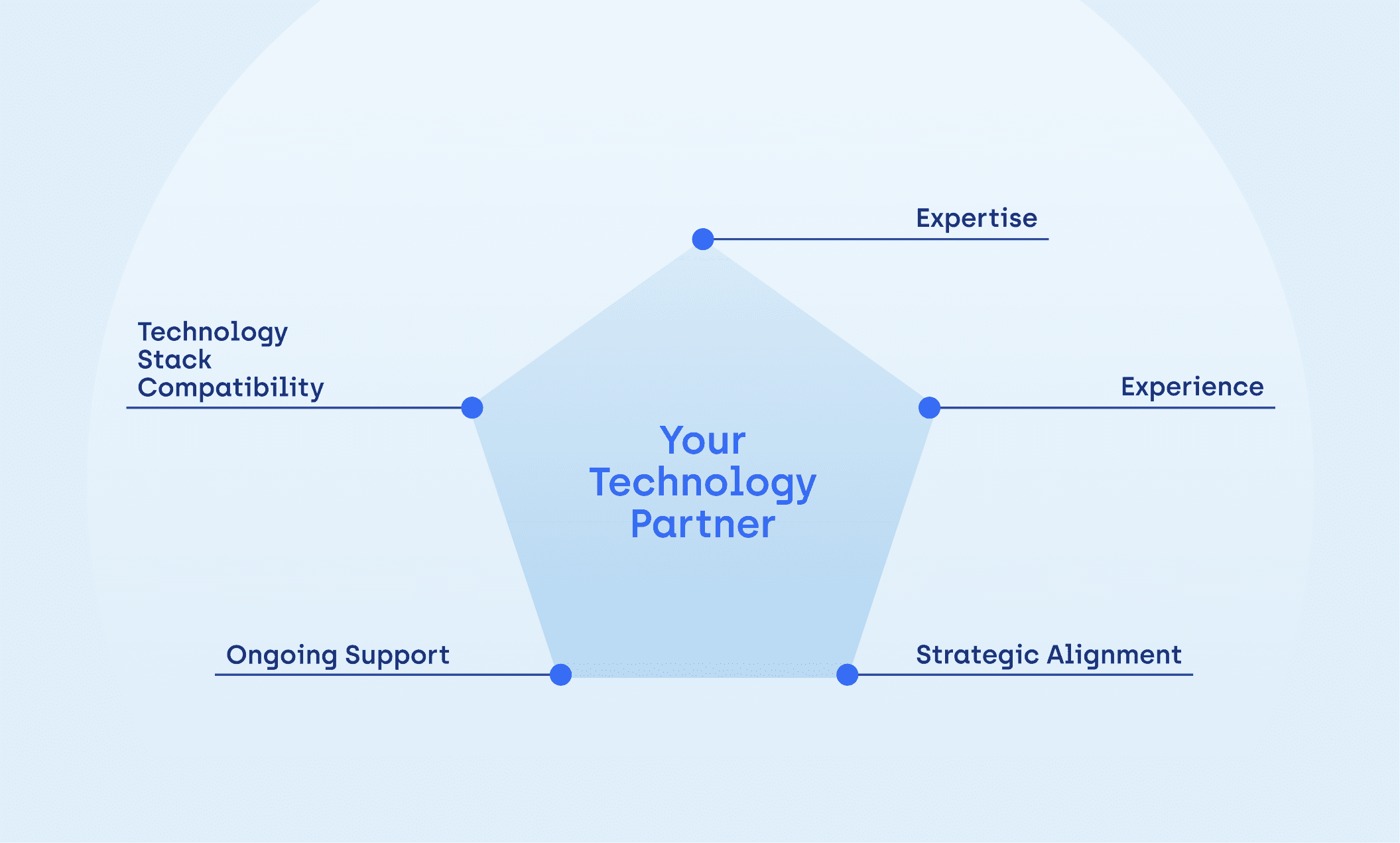
Let's bridge the gap between the past and the future of your technological landscape!
Hero/dot is a software house with over 10 years of experience in large scale digital transformation projects with a substantial legacy modernization component. We offer our clients the needed resources, methodologies and expertise to remodel their legacy systems into cutting-edge, cost-effective, and optimized solutions. Take the first step on your legacy modernization journey and contact us now!
Need expert assistance with your digital project?
